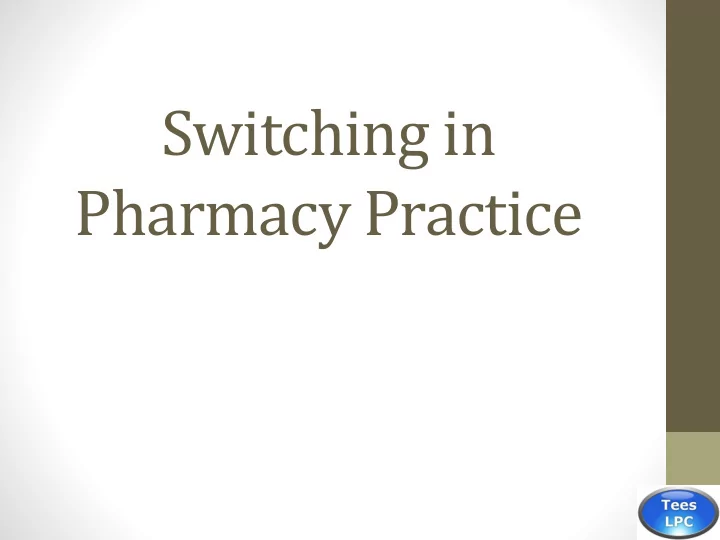

Switching in Pharmacy Practice
What is Switching • Switching is where a prescription that should be Non Levy has insufficient exemption endorsements made on the back, resulting in a default to levy status. T his means the NHS think we have collected a levy when we haven’t. • This process can no longer be blamed on NHS IT systems, since prescriptions are no longer automatically switched from ‘exempt’ status to ‘paid’ by the Pricing Authority. Any form that is identified as a potential candidate for switching is now referred to an operator to assess the prescription and make the final decision over whether the prescription should be ‘switched’. • Hence Switching is FULLY in our control.
Why Does Switching Matter? • With recent waves of government funding cuts we now get paid less for dispensing items. The government deem that remuneration is fair, but they do not account for any switching losses in the calculation of our payment structure. It is our responsibility to ensure prescriptions are completed correctly. • Last year switching cost some pharmacies upwards of £50,000, and some companies more than £1M. Just think what pharmacy could do with this extra money: more staff hours? Better hourly rates? Better bonuses? Pharmacy refits? • In some pharmacies in England, switching makes the difference between profit and loss • Get paid for what we are entitled to!!
Why Does Switching Occur? Prescription switches generally occur at the BSA for 2 main reasons: ● The declaration on the back of an exempt prescription has not been completed correctly by the patient. ● A paid prescription has been incorrectly filed with exempt prescriptions by the pharmacy, before submission. Paid and exempts must be separated and not merged together in end of month box! The Department of Health will not grant any concessions for a pharmacy’s failure to ensure exemption declarations are completed where required; therefore it is essential that all contractors review their prescription receipt and processing procedures. Incorrect declarations by the pharmacy may result in BSA fines! Ensure that if evidence is not seen, this is annotated on the paper rx and electronically if EPS
Switching Types • Paper : losses incurred when the exemptions are incomplete or ambiguous • EPS : There is no such thing as EPS switching! Levies are paid to us according to the submission made so the pricing authority will not be able to switch like paper prescription. EPS switching losses are incurred when either exemptions are incomplete or partially complete (token doesn’t match the exemption on the Pharmacys ’ claim system). EPS cannot switch; if we incur it’s a loss it is due to the back not being completed. • So how do we prevent these switches from happening?
Tips on How to Prevent Switching • Check the back of every exempt prescription (ideally when handing over the medication to the patient) to ensure that: - an exemption box in part 1 of the declaration has been clearly marked (for example tick or cross) - the ‘amount paid’ box in part 2 of the declaration has not been obscured/ marked - there is a signature in the signature box (part 3) of the declaration - (this is especially important when a patient is signing multiple prescriptions at a time) • Ensure that all prescriptions are filed correctly in the paid or exempt sections at the end of every day. • Double-check exempt prescriptions for misfiled paid prescriptions before submission at the month end. • Please note: a pharmacy stamp is not accepted as a signature in a declaration of exemption. If a prescription is submitted without a valid signature in part 3, it could be switched. • You do not need to use a particular coloured pen to complete exemption declarations; this has no impact on whether an item is switched. However, it is good practice to use Black pen
When to claim EPS in the month? • When Levies are taken from patients in one month, and the corresponding EPS token is claimed in another, this causes large swings in switching losses from positive to negative. • Ensure EPS scripts are always claimed in the month in which the levy was taken. This is crucial for paid EPS scripts. • EPS scripts must be claimed in that month to count for that month. i.e. there is no leeway into the following month when the rx box is collected. • Hence the rule is “If its paid that month, its claimed that month”
Key Actions to Reduce Switching in Any Pharmacy • Ensure every back is complete including age exempt. We know that age exempt doesn’t have to be complete if age is printed. However, allowing some backs to not be completed creates a bad culture. • Keep copies of FP34C and MRS submission. • Ensure company processes for Paper and EPS prescription claiming are embedded. • Check claiming screens are up to date with the correct exemptions • Ensure daily and end of month filing is correct in relation to paid and exempt. • Claim items in the correct month • Use the evidence not seen box when appropriate; this is commonly forgotten for EPS scripts. • Understand how much money you have lost each month from the switching in your pharmacy (your area manager or owner would usually have this detail)
Recommend
More recommend